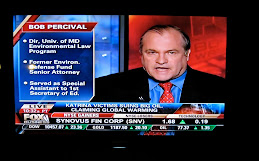On Thursday October 16 I flew to Austin, Texas to participate in the annual meeting of the American College of Environmental Lawyers (ACOEL). The group is an organization of environmental lawyers whose membership is elected and capped at 250. The vast majority of the members work for law firms, but there are some academics and lawyers for government agencies or NGOs as well. On Friday October 17 EPA General Counsel Avi Garbow gave the keynote address to the group. He noted that he had recently visited China where he had the honor of presenting a medal to the U.S. Foreign Service officer in the Beijing Embassy who had been responsible for creating a Twitter feed providing real time data on levels of particulate matter (PM). The public interest generated by this development helped spur the Chinese government to establish an air quality standard for PM 2.5. Garbow also stated that he had visited Ma Jun whose Institute of Public and Environmental Affairs has launched an app that allows the Chinese public to obtain pollution data on their smart phones. Garbow noted that EPA’s has a “My Green Apps” webpage (http://www.epa.gov/mygreenapps/), though a quick visit to it indicates that EPA is no longer updating the page to list new environmental information apps.
On Saturday October 18 John Cruden, the president of ELI, and I gave a presentation to ACOEL on “Cases of the Year: Environmental Law in the Supreme Court.” We reviewed the Court’s three major environmental decisions last year: EME Homer City, which upheld EPA’s air transport rule to control interstate air pollution, Utility Air Regulatory Group, which largely upheld EPA’s regulation of greenhouse gases for sources that require PSD permits, and CTS v. Waldburger, which held that CERCLA § 309 imposes a federal discovery rule that tolls only state statutes of limitations and not statutes of repose. The Supreme Court has not yet agreed to hear any significant environmental cases this Term, but we discussed four cases the Court will hear that may have some implications for environmental law. We also reviewed some cert petitions that are before the Court and agreed that EPA’s mercury and air toxics (MATS) rule is the most likely candidate for Supreme Court review this Term.
On October 17 a group of protesters from South Pacific islands blocked the port of Newcastle, Australia to protest coal exports that contribute to climate change. The protest, organized by the group 350.org, targeted Austrlian Prime Minister Tony Abbott’s efforts to expand Australian coal exports. The Australian government has repealed coal and carbon taxes while approving new ports for coal exports. Last week the Australian government criticized a decision by Australian National University to divest assets held in fossil fuel companies. The Australian think tank Australian Institute responded with an open letter signed by prominent Australians, including former conservative prime minister Malcolm Fraser defending the university. Jamie Smyth, Green Groups Take Aim at Champions of Australia’s Burgeoning Coal Industry, Financial Times, Oct. 18-19, 2014, at 4.
During the past month there has been a sharp decline in oil prices from over $100 per barrel to nearly $80. Taking advantage of this surprising drop, Indian Prime Minister Narendra Modi has just ordered an end to government subsidies on the price of diesel fuel, while raising the regulated price of natural gas by one-third. The diesel oil subsidies cost the Indian government $23 billion last year. James Crabtree, Modi Ends Diesel Subsidy and Continues Reform Drive, Financial Times, Oct. 20, 2014, at 4. Another benefit from the plunge in global oil prices is that it has intensified the economic pain of sanctions on the Russian government. Thomas Friedman, A Pump War, New York Times, Oct. 15, 2014. A critic of green energy who has a regular column on the editorial pages of the Wall Street Journal expressed glee that lower oil prices would reduce investments in renewable energy. Holman Jenkins, Cheap Oil Pops the Green Policy Bubble, Wall Street Journal, Oct. 15, 2014.
The Carbon Disclosure Project reported last week that both Exxon Mobil and Royal Dutch Shell increased their greenhouse gas emissions last year despite producing less oil. Daniel Gilbert, Wall Street Journal. The carbon intensity of their oil production (GHG emissions per barrel of oil produced) has increased ten percent since 2011. The increased carbon intensity of their production is attributed to the increasing difficulty of extracting oil from more remote sources. By contrast, Chevron and BP have slightly reduced the carbon intensity of their production since 2011.
On Sunday October 19 the 34th Beijing International Marathon was run despite severe air pollution in China’s capital. Chinese authorities rated Beijing’s air as “heavily polluted,” a level that comes with a warning to avoid outdoor activity. Many runners wore masks or used wet sponges in the race. Girmay Birhanu Gebru of Ethiopia won the men’s race, while his fellow countryman Fatuma Sado won the women’s.
The midterm elections are rapidly approaching in the U.S. with control of the U.S. Senate hanging in the balance. One candidate who currently is leading in the polls in my home state of Iowa wants to abolish the U.S. Environmental Protection Agency, an issue that was front and center during a candidates’ debate on Oct. 11. Republican candidate Joni Ernst argued that the state of Iowa could do a better job of protecting the environment if EPA were abolished.

















